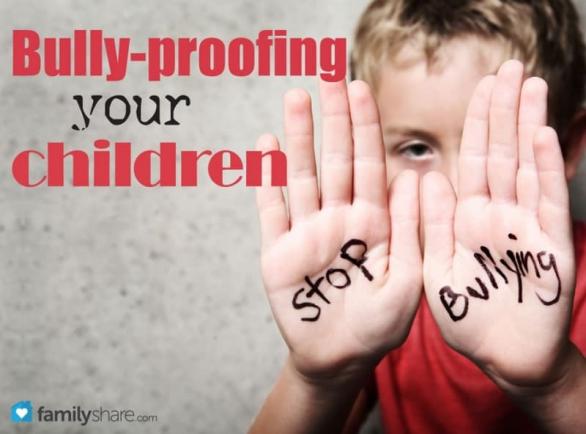
Almost everyday we are affected by bullies. Our children are often bullied in and out of school. We read dreadful stories of children going to drastic measures to escape bullies, even taking their own lives. It even transpires online. We spend a lot of time talking about solutions. It's time to bully-proofour children.
First, some facts and statistics:
Definition of bullying
Asserting power through aggression and may include:
-
Physical attacks or violence.
-
Teasing, name-calling, put-downs.
-
Threats or intimidation.
-
Extorting personal property or money.
-
Exclusion from groups.
Bullying myths
-
Bullying is a phase and is normal for kids to go through.
-
If I tell someone, it will get worse.
-
You should stand up to them or hit them back.
-
People are born bullies.
-
Bullying is a school issue and should be handled there.
Bullying truths
-
It is not normal.
-
It is not a phase.
-
Research shows that bullying will stop when adults in authority and peers get involved.
-
Bullying can happen anywhere.
-
It is a learned behavior and can be changed.
Bullying statistics
-
It is about 50/50 boys and girls with boys being more physical and girls dealing more with gossip or exclusion.
-
Though bystanders are drawn to watch, 83% of them reported it making them feel uncomfortable.
-
When peers intervene, bullying stops in less than 10 seconds 57% of the time.
-
If the principal of a school is actively involved in prevention, bullying is reduced.
Children need to know that bullying is not just a normal part of growing up. They also need to know that standing and watching is contributing to the problem. Bullying is fueled by the attention of observers.
While we need to try to figure out solutions to the bullies themselves, for the time being they exist and we need to teach the victims and the bystanders how to react and behave to be a part of the solution.
What to teach bystanders
-
Walk away; encourage other bystanders to also walk away; go and get help from an adult in authority.
-
Pay attention to where bullying most often takes place and tell adults so that they can monitor that area.
-
Speak up to the bully. Let them know that you won't participate and that they are wrong.
-
Help the victim.
-
Don't join in the taunting and teasing or in any way promote the aggression.
-
Don't fight the bully yourself.
-
Tell an adult what is going on. Telling is not the same as tattling.
What to teach victims
-
Hang out with friends. Make friends with other kids who are alone or vulnerable.
-
Join groups and activities.
-
If you walk to school, walk with someone else.
-
If you take a bus, sit up near the driver.
-
Avoid the 'hot spots' where bullies like to hang out.
-
Don't bring extra money or electronics to school. That can make you a target.
-
Look confident, even if you're not. Look bullies in the eye. Don't slouch or look down a lot. Don't act scared.
Signs your child may be bullied
-
Trouble sleeping; wetting the bed.
-
Stomach or headaches; loss of appetite; throwing up.
-
Fear of going to school, asking to stay home a lot; too many visits to school nurse.
-
Crying before or after school.
-
Lack of interest in school events.
-
Lowered self-esteem.
-
Change in behavior, dress or habits.
-
Missing personal items or money.
-
Injuries or bruises and trouble explaining them.
-
Acting out or aggression at home.
-
Lower grades and decreased participation; lack of homework.
What you, as a parent, can do
In addition to talking to your children about the above tactics, here are some additional steps you can take:
Get involved
Volunteer at school. Talk to other parents.
Speak to administration
Ask about school policy on bullying and if there isn't one, insist that one be drawn up and enforced.
Speak to teachers
Find out if anything has changed with your child. Partner with them and confide in them if you are seeing things at home.
Speak to counselors
Alert them to any concerns you may have about your child.
If a threat has been made to your child,
take it up immediately with administration, school safety officers, counselors, teachers, etc. Make some noise.
Keep a record
Keep a notebook of all conversations, contacts, incidents, changes in behaviors, concerns, etc. Make sure to date and time all entries.
If your child is a bully,
take immediate action. Get help for him or her. Speak to professionals.
I have previously written an article 'How not to raise a wimp' which encouraged you not to always jump in when you see altercations and to let kids work things out themselves. Bullying is quite another matter. Bullying, left unchecked, can cause serious psychological damage, extreme lost of self-esteem, and can even lead to suicide. You, as a concerned parent, will be able to know the difference. Trust your instincts. If you have serious concerns, act on them. Don't let it go because you are afraid to make waves. You'll know when to get in your child's corner.

